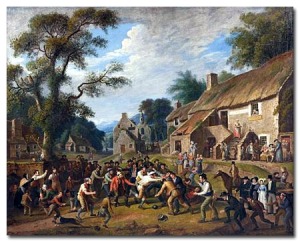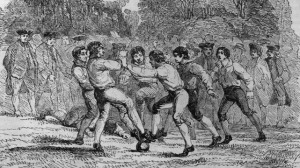16. Rustical Diversions: British football in the seventeenth and eighteenth centuries
He wasn’t massively popular, and two years into his reign he came close to copping it when a certain Robert Catesby sent his pal Guy Fawkes to try to blow him up. For football’s sake, it was a good thing the plot failed, as James was quite fond of the game.
 The first known case of the word ‘football’ appearing using the modern spelling actually appears in Shakespeare, where in ‘Comedy of Errors’ of about 1594 it is asked “am I so round with you as you with me that like a football you spurn me thus?” It is often from poetry that we get the best idea of the medieval game, such as John Gay writing in 1716 of how “I spy the furies of the football war, the prentice quits his shop to join the crew, increasing crowds the flying game pursue” or an anonymous scribe from 1735 explaining how “the nimble foot-ball scours the fields of air, they kick, they push and pushing loudly cry.”
The first known case of the word ‘football’ appearing using the modern spelling actually appears in Shakespeare, where in ‘Comedy of Errors’ of about 1594 it is asked “am I so round with you as you with me that like a football you spurn me thus?” It is often from poetry that we get the best idea of the medieval game, such as John Gay writing in 1716 of how “I spy the furies of the football war, the prentice quits his shop to join the crew, increasing crowds the flying game pursue” or an anonymous scribe from 1735 explaining how “the nimble foot-ball scours the fields of air, they kick, they push and pushing loudly cry.”
Scotland still had a particular passion for the game, which is where David Wedderburn published a particularly revealing text in 1607. It was written in Latin for pupils to translate, and although it would seem to mention such concepts as goalkeepers and players kicking the ball to each other, we can’t be sure if that is what is really being said or whether that really means Scotland can claim to have invented the passing game.
Passing or not, the Scottish authorities weren’t always too impressed. In Perth in 1556, anyone playing football would pay a “penalty of a pound of wax,” Elgin banned “footballing through the toun” in 1599 and “drinking, playing football … and roving from parish to parish” were outlawed on the Sabbath in Aberdeen in 1607. But although one game at Lochton in 1601 “fell in contentioun and controversie” to such an extent that pistols were drawn, it was football’s interference with work and worship rather than its dangers that were the real concern.
 Despite these bans in Caledonia, the arrival of a Scotsman, James I, on the English throne in 1603 proved positive for athletic pursuits of all kinds. He was shocked by what his ‘Book of Sports’ of 1618 called “the prohibiting and unlawful punishing of our good people for using their lawful recreations and honest exercises upon Sundays” and asked “when shall the common people have leave to exercise … seeing they must apply their labor and win their living in all working days?”
Despite these bans in Caledonia, the arrival of a Scotsman, James I, on the English throne in 1603 proved positive for athletic pursuits of all kinds. He was shocked by what his ‘Book of Sports’ of 1618 called “the prohibiting and unlawful punishing of our good people for using their lawful recreations and honest exercises upon Sundays” and asked “when shall the common people have leave to exercise … seeing they must apply their labor and win their living in all working days?”
Although football wasn’t specifically mentioned in that decree, we do know he appreciated it because in 1615 he was taken to game by a minister in Wiltshire, and “for this entertainment his Majesty made him one of his chaplains.” However, James I probably never played the game himself, writing in 1599 that “I debarre all rough and violent exercises, as the footeball, meeter for laming.” Nevertheless, the 17th century brings many cases of noblemen who did, including Oliver Cromwell who was described in 1628 as “one of the chief matchmakers and players of football” while studying at Cambridge, and Charles II happily wagered money on the outcome of a game in 1681.
Football games were particularly common at two times of year: Shrove Tuesday (carnival) and New Year. Several symbolic reasons have been offered for that, particularly that football evolved out of pagan rituals associated to these feast days. But the real reason would seem to be that these were the only days of the year when the common folk were able to gather for sports and other entertainments. They had to work for six days a week, and Sundays were reserved, often by force, for worship and rest. Clergy like the rector of the Cumbrian town of Ousby, who after afternoon prayer took the congregation to the local alehouse, and “set the younger sort to play at football,” were very much the exception rather than the norm.
 One of the most revealing football texts from the period was included in Francis Willughby’s ‘Book of Plaies’ of around 1660. He clearly states that players had to kick, not carry or throw, the ball to their opponent’s goal, and that the teams “are equally divided according to their strength and nimbleness … they usually leave some of their best players to guard the goal.” Three centuries before the FA supposedly ‘created’ it, Willughby is clearly describing soccer as opposed to the stereotypical idea of medieval ‘mob’ football, and indeed maps and legal documents from this period frequently referred to a football ‘close’, ‘garth’ or ‘field’ where the game was played without causing any apparent disturbance.
One of the most revealing football texts from the period was included in Francis Willughby’s ‘Book of Plaies’ of around 1660. He clearly states that players had to kick, not carry or throw, the ball to their opponent’s goal, and that the teams “are equally divided according to their strength and nimbleness … they usually leave some of their best players to guard the goal.” Three centuries before the FA supposedly ‘created’ it, Willughby is clearly describing soccer as opposed to the stereotypical idea of medieval ‘mob’ football, and indeed maps and legal documents from this period frequently referred to a football ‘close’, ‘garth’ or ‘field’ where the game was played without causing any apparent disturbance.
History has tended to focus on official bans and the reports of deaths and mayhem, often just because these paint a far more exciting image. Less commentary is given to such texts as one in 1711, whereby the author witnessed “a football match which was on the other side of the green, where Tom Short behaved himself so well that most people seemed to agree it was impossible that he should remain a batchelor till the next wake.” These harmless matches were largely ignored, because they were that – harmless and of little interest to anyone other than the players themselves.
 But that doesn’t mean football didn’t cause trouble now and again. Perhaps the first full match report was on a terrific game played between Selkirk and Yarrow in Scotland in 1815. But despite the fun, the practice was discontinued for “it was not always safe to have even the game of football between villages. The old clannish spirit was too apt to break out.” Manchester put a stop to the “unlawful exercise of playing with the ffotebale in ye streets” because of the damage it was causing, and other towns and cities did likewise, but the biggest fear would seem to have been that such riotous gatherings could spill over into even greater disturbances, such as the case in 1740 when “a mach of futtball was cried at Kettering of five hundred men of a side, but the design was to pull down Lady Betey Jesmaine’s Mills” and another in Northamptonshire in 1765 that was really an excuse to gather men to violently protest against the Enclosure Acts.
But that doesn’t mean football didn’t cause trouble now and again. Perhaps the first full match report was on a terrific game played between Selkirk and Yarrow in Scotland in 1815. But despite the fun, the practice was discontinued for “it was not always safe to have even the game of football between villages. The old clannish spirit was too apt to break out.” Manchester put a stop to the “unlawful exercise of playing with the ffotebale in ye streets” because of the damage it was causing, and other towns and cities did likewise, but the biggest fear would seem to have been that such riotous gatherings could spill over into even greater disturbances, such as the case in 1740 when “a mach of futtball was cried at Kettering of five hundred men of a side, but the design was to pull down Lady Betey Jesmaine’s Mills” and another in Northamptonshire in 1765 that was really an excuse to gather men to violently protest against the Enclosure Acts.
But these problems and prohibitions were generally isolated cases, and it is not certain that this is why there was a surprising drop in football’s popularity as the 18th century came to an end, and its defining period, the 19th century, was about to begin. Joseph Strutt, for example, wrote in 1801 that the game “was formerly much in vogue among the common people of England, though of late years it seems to have fallen into disrepute and is but little practised,” a year after The Sporting Magazine had written that “football is fast going out and leap-frog is now the full sport of the day.” Little changed for a quarter of a century. In 1823 it was written that “football is an exercise which has dwindled into nothing compared to the estimation in which it was formerly held” and the same was true north of the border, where it was said in 1825 that football “was anciently a very popular sport all through Scotland” but now was now only played in a few rural outposts. Possible reasons why this should be are discussed in a later chapter.
Click here to buy the book and read the whole story.

Leave a comment
Comments 0